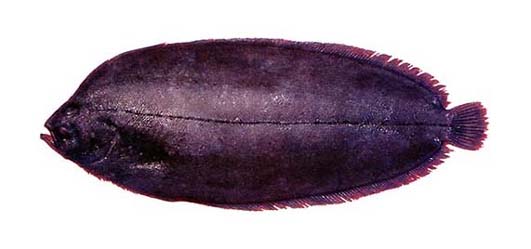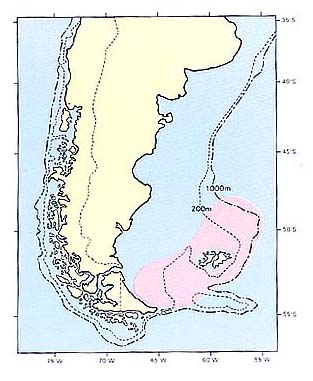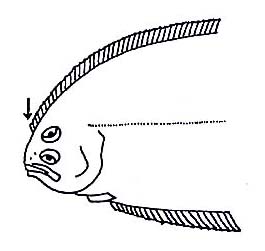ダルマガレイ科
- HOME
- デジタル図鑑
- パタゴニア海域の重要水族
- 硬骨魚綱 カレイ目
- ダルマガレイ科
ダルマガレイ科(Bothidae)

127 テナシビラメ(Tenashibirame)
Mancopsetta tricholepis(Norman, 1930)
Lenguado(Arg.)
特 徴:
背鰭131軟条,臀鰭110軟条,腹鰭7(有眼側),6(無眼側),尾鰭18軟条,側線鱗数186,鰓条骨数7,鰓耙数4+8=12,脊椎骨数17+48=65。頭長は体長の19.3%,眼径は24.6%(有眼側),24.5%(無眼側),体高は21.7%,体幅は頭長の21.8%,吻長は15.4%,両眼間隔は9.3%,上顎長は36.9%(有眼側),35.5%(無眼側),下顎長は43.5%(有眼側),50.1%(無眼側),尾柄高は43.1%,背鰭高は29.2%,臀鰭高は26.2%,腹鰭長は18.5%(有眼側),15.4%(無眼側),腹鰭基底長は32.3%(有眼側),16.9%(無眼側)。体形は延長した卵円形で,体中央部は肉厚。頭は小さく,頭長は体長の1/5以下。頭部背縁は直線状。吻は円鈍で短い。眼は左側にあり,下眼は上眼よりわずかに前方に位置する。両眼間隔域は狭い。有眼側の一対の鼻孔は相接近し,下眼の上縁の直前に位置し,前鼻孔は管状で後縁に長い1皮弁を有し,後鼻孔も管状で後縁で小欠刻を有する。口は小さく,斜位。両顎はほぼ同程度に発達する。上顎後端は下眼中央下に達する。両顎歯は内側に少し湾曲する可倒性の小円錐歯で,前方を除いて1列に並ぶ。両顎歯は両眼側で,ほぼ同等に発達する。第1鰓弓上枝状の鰓耙は小さくて短く,下枝上の鰓耙は平たく先端は丸味を帯びる。両眼側の鱗は微小な櫛鱗で脱落しにくい。側線は単線で,ほぼ直線状,両眼側ともほぼ同等。肛門は無眼側に開くが,ほぼ腹縁近くに位置する。
分 布:
アルゼンチン パタゴニア。
備 考:
本種の正模式標本(副模式標本はない)は小さくて(体長 100 mm),まだ種の特徴を明確に表わしていないので,その後に多くの種が記載され,Achiropsetta-Mancopsetta群(胸鰭のないヒラメ類)の分類は混乱している。Andriashev(1960)によって記載されたAchiropsetta slavae(浮遊期若魚)は本種の異名と考えられる。
(中村 泉)
Material examined:
1 from Argentina (340.0 mm SL), FAKU 42725.
Description:
D 131; A 110; P17 (ocular side), 6 (blind side); C 18; LLS 186; BR 7; GR 4+8=12; V 17+48=65.
HL 19.3% of SL; ED 24.6 (ocular side), 24.5 (blind side); BD 21.7; BW 21.8% of HL; SN 15.4; IO 9.3; UJ 36.9 (ocular side), 35.5 (blind side); LJ 43.5 (ocular side), 50.1 (blind side); CP 43.1; DH 29.2; AH 26.2; P1L 18.5 (ocular side), 15.4 (blind side); P1 base L 32.3 (ocular side), 16.9 (blind side)
Body elongate oval, thick and muscular in central portion. Head small, less than 1/5 of SL. Snout blunt and short. Eyes sinistral, small, lower eye slightly anterior to upper. Interorbital region narrow. Nostrils on ocular side closely situated each other just anterior to upper margin of lower eye, anterior nostril tubular with a long flap posteriorly, posterior nostril also tubular with a small notch posteriorly. Mouth oblique, small, both jaws about equally developed. Posterior end of upper jaw extending level of center of lower eye. Teeth small, slender conical, depressible, curved inward, arranging uniserial except on anterior part of both jaws. Dentition about equally developed on both jaws. Gill-rakers on upper limb of first arch small and short, those on lower limb flat with round tip. Fine ctenoid scales not deciduous on both ocular and blind sides. Lateral line nearly straight, running along body axis, and equally developed on both sides. Anus opening on blind side, but extremely close to ocular side.
Distribution:
Argentine Patagonia.
Remarks:
Holotype of this species is a juvnile specimen (100 mm), so further study of Achiropsetta-Mancopsetta group is needed. Pelagic young flatfish, Achiropsetta slavae newly described by Andriashev (1960) is probably attributable to A. tricolepis.
(Izumi NAKAMURA)

Distribution of Mancopsetta tricolepis in Patagonia.

Head. Dorsal fin origin arrowed.